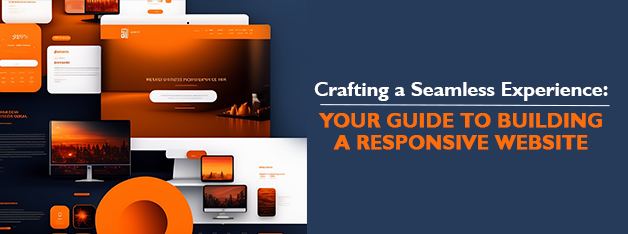Crafting a Seamless Experience: Your Guide to Building a Responsive Website

Introduction:
Hello! In today’s digital world, having a responsive website is absolutely crucial. It’s the key to reaching and engaging with a wider audience across different devices. If you need information on building a responsive website, you’re in the right place. In this blog post, we’ll walk you through the process step by step, from planning to optimization, ensuring your site stands out with its uniqueness and excellence.
Step 1: Define Your Goals and Know Your Audience
First things first, let’s define the purpose of your website and understand who your target audience is. Ask yourself what you want to achieve with your site—whether it’s to showcase your portfolio, sell products, or provide valuable information. By understanding your audience’s needs, preferences, and browsing habits, you’ll be able to tailor your design and content to meet their expectations.
Step 2: Sketch Out Wireframes and Create Prototypes
Now, let’s bring your ideas to life by creating wireframes. Start by sketching out the key elements and their placement on each page. This visual blueprint will help you organize your content effectively and plan the user flow. Once you’re satisfied with your wireframes, it’s time to create interactive prototypes using tools like Adobe XD, Sketch, or Figma. Prototyping allows you to test the usability and interactivity of your design before diving into Website development.
Step 3: Embrace Responsive Frameworks or Grid Systems
Building a responsive website doesn’t mean reinventing the wheel. Take advantage of responsive frameworks or grid systems like Bootstrap, Foundation, or Materialize CSS. These handy tools provide pre-built components and a responsive grid system, making it easier to create a mobile-friendly layout. With their help, your website will adapt seamlessly to different screen sizes without compromising style or functionality.
Step 4: Prioritize Mobile-First Design
When it comes to responsive design, “mobile-first” is the way to go. Start designing for smaller screens and progressively enhance the layout for larger devices. By focusing on the essential content and optimizing the user experience for mobile users, you’ll ensure your website looks fantastic and performs flawlessly on smartphones and tablets. Remember, simplicity and intuitive navigation are key!
Step 5: Go with the Flow—Fluid Layouts and Flexible Elements
To achieve responsiveness, embrace fluid layouts and flexible elements. Avoid fixed pixel-based widths and instead use relative units like percentages, ems, or viewport units (vw, vh). These units, combined with CSS flexbox or grid systems, allow your website’s layout to adapt fluidly across devices. The goal is to create an experience where text, images, and other elements resize and reposition smoothly for optimal readability and usability.
Step 6: Media Queries—Your Responsive Magic
Media queries are your secret weapon for customizing styles based on the device’s characteristics. By setting breakpoints in your CSS code, you can define when the layout or design should change to fit different screen sizes. Adjust typography, padding, margins, and reposition elements to ensure a cohesive experience. Media queries empower you to provide a visually stunning website on every device.
Step 7: Optimize Images and Media for Speed
A responsive website should be both visually appealing and fast-loading. Optimize your images by compressing them without compromising quality. Explore modern image formats like WebP to reduce file sizes further. Implement lazy loading techniques, so images load as users scroll, improving initial page load times. Additionally, use responsive embeds for videos and other media, ensuring they seamlessly adjust to different screen sizes.
Step 8: Testing, Testing, 1-2-3!
Before launching your responsive website, thorough testing is a must. Grab as many different devices and check with all of them. On mobile devices please check both landscape and vertical orientations.
